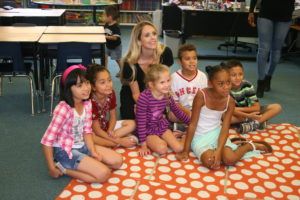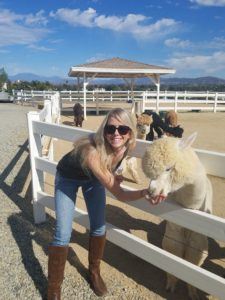How pets are connecting kids in our new virtual world: RedRover Readers Spotlight with Sarah Kesty
June 12th, 2020
By Tara Lenehan, RedRover Education Coordinator
 “People’s humanity comes out when we talk about animals together.”
“People’s humanity comes out when we talk about animals together.”
Sheltering at home during the pandemic has brought unique challenges for all of us – and for educators, finding ways to engage and connect with students virtually has been a huge learning experience.
For Sarah Kesty, a California educator who trained with RedRover Readers in 2011 and was named Sacramento County 2015 Teacher of the Year, teaching in the time of quarantine has been eye-opening. She has found that her background in social and emotional learning (SEL) has been especially helpful during this period of social distancing.
After schools shut down earlier this year, Sarah worked with the California Department of Education and joined an innovation task force focused on special education. In exploring how to best help families help their kids with at-home, virtual learning, Sarah felt a powerful collaboration.
“There was a sense of teamwork emerging that wasn’t necessarily there before because you’re teaching alone in your classroom all day,” she said. Now, her school district was sending trauma-informed resources, and the general perspective was changing.
“Parents are recognizing just how much teachers are doing,” Sarah went on. “That teamwork and new appreciation really feels good – that’s new and uplifting for me.”
 That teamwork included a collective shift toward well-being, focusing on community and mental health. Sometimes these school-wide approaches looked like extended deadlines, making sure social and emotional needs are being met and providing appropriate resources for families. This also means allowing more space for students to share their thoughts and experiences with one another.
That teamwork included a collective shift toward well-being, focusing on community and mental health. Sometimes these school-wide approaches looked like extended deadlines, making sure social and emotional needs are being met and providing appropriate resources for families. This also means allowing more space for students to share their thoughts and experiences with one another.
Sarah observed that prioritizing social and emotional development has seemed to benefit at-home learning, especially during virtual Zoom classes. Now, students have a more intimate window into their classmates’ lives – and they love doing “show and tell” with their pets.
“Pets can be a greater connector and opener to get kids talking and engaging with each other,” Sarah explained.
Sarah’s first week check-in was “show me your pet,” and she got the “cutest, gushiest responses, even from the tough 8th grade boys.” Animals are a neutral party that are here to love us unconditionally. They do not judge us, talk back or argue with us. As Sarah puts it, “the humanity comes out when we talk about animals together.”
While it appears students are more plugged in than ever before, Sarah has also noticed that her students are beginning to develop a new level of awareness where they finally seem sick of technology and ready to unplug. This decision to observe the natural world has been self-selecting, rather than forced, so they are genuinely curious and are “unplugging in meaningful ways.”
Change and transition can feel overwhelming for a lot of people, adults and parents included. For many of Sarah Kesty’s students, their pets provide a sense of comfort and stability. These young people have been “really connecting with animals now during this time because there’s not much in the world that’s making them feel safe, and their animals do.”



